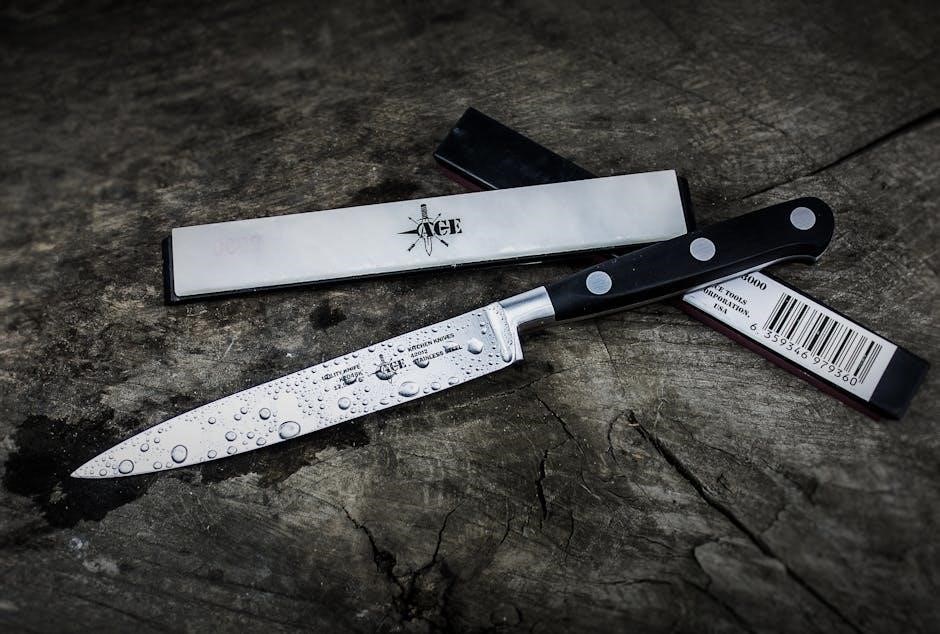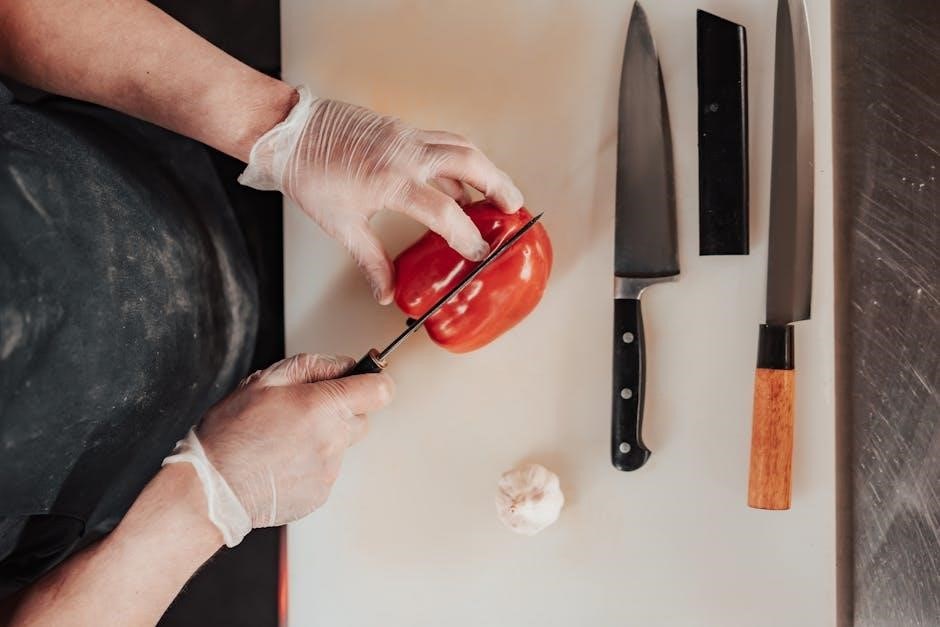Knife Angle Guides: A Comprehensive Overview
Knife angle guides are essential tools designed to assist both novice and experienced sharpeners. They maintain consistent sharpening angles. These guides are crucial for achieving a precise and uniform edge on various types of blades‚ ensuring optimal cutting performance.
Knife angle guides are invaluable tools for anyone seeking to achieve a consistently sharp edge on their knives. These devices help maintain the correct angle between the blade and the sharpening stone‚ eliminating guesswork and reducing the risk of damaging the knife. Ideal for beginners‚ they promote uniform sharpening‚ ensuring each part of the blade receives equal attention. By using angle guides‚ sharpeners can achieve professional-quality results‚ increasing the lifespan and performance of their knives‚ while also developing essential sharpening skills.

Understanding Knife Sharpening Angles
Understanding knife sharpening angles is crucial for maintaining blade sharpness and performance. Different knives require specific angles to optimize their cutting ability and edge retention. This knowledge ensures effective sharpening and prolongs knife life.
Importance of Maintaining a Consistent Angle
Maintaining a consistent angle during knife sharpening is paramount for achieving a razor-sharp edge. Inconsistent angles result in a rounded or uneven blade‚ diminishing cutting efficiency. Consistent sharpening ensures the entire blade edge is sharpened uniformly‚ maximizing its potential. Utilizing angle guides helps achieve this consistency‚ especially for beginners. This results in a knife that performs optimally‚ reducing the effort needed for cutting tasks and ensuring safety through controlled precision.
Common Knife Sharpening Angles by Knife Type
Different knives require specific sharpening angles to optimize their performance. Kitchen knives typically benefit from a 20-degree angle‚ balancing sharpness and durability. Asian-style knives often use a 16-degree angle for enhanced precision. Pocket and hunting knives‚ designed for tougher tasks‚ commonly employ angles between 20 and 25 degrees. Fillet knives‚ requiring flexibility‚ often have a 16-degree angle. Understanding these variations is crucial for effective sharpening and preserving the intended use of each knife.
Types of Knife Angle Guides
Knife angle guides come in various forms. These forms include clip-on guides‚ sharpening stone guides‚ and pyramid guides. Each type offers a unique approach to maintaining consistent angles during the sharpening process.
Clip-On Angle Guides
Clip-on angle guides are designed for easy attachment to the spine of a knife blade. This ensures the user maintains a consistent angle while sharpening on a whetstone or other sharpening surface. They often feature ceramic skates to glide smoothly across the stone. Clip-on guides are beneficial for achieving factory-edge sharpness. They are suitable for both wide and narrow blades. These guides are simple and effective for maintaining the perfect edge angle.
Angle Guides for Sharpening Stones
Angle guides designed for sharpening stones often come as part of a set. These guides sit on the stone‚ providing a visual and tactile reference for maintaining the correct angle. They are particularly useful for beginners‚ offering a clear indication of the sharpening angle. They eliminate the guesswork involved in freehand sharpening. These guides are compatible with various types of flat sharpening surfaces. This includes both water and oil stones. They enhance precision and consistency during the sharpening process.
Pyramid Angle Guides
Pyramid angle guides offer a versatile solution for achieving precise sharpening angles. These guides feature a pyramid shape‚ providing multiple universal angles. Common angles include 14‚ 17‚ 20‚ and 25 degrees. The pyramid shape ensures consistent and accurate angles during sharpening. They are engineered to assist in maintaining the correct angle between the blade and the sharpening surface. These guides are especially helpful for knives with specific bevel angles. This type of guide ensures consistency across the entire edge.
Using Knife Angle Guides Effectively
Using knife angle guides effectively involves selecting the correct guide for your knife’s bevel. Proper attachment and positioning are crucial. Maintaining the angle during sharpening ensures a consistent‚ sharp edge. Practice makes perfect!
Selecting the Correct Angle Guide
Choosing the right knife angle guide is pivotal for achieving optimal sharpening results. Start by identifying the factory edge angle of your knife‚ consulting manufacturer specifications whenever possible. If unknown‚ a general guideline suggests using lower angles (15-20 degrees) for kitchen and fillet knives and higher angles (20-25 degrees) for pocket and hunting knives. Select a guide that closely matches this angle to maintain the blade’s original characteristics and cutting performance. Consider adjustable guides for versatility.
Attaching and Positioning the Guide
Proper attachment and positioning of the knife angle guide are crucial for consistent sharpening. Clip-on guides should be securely fastened to the spine of the blade‚ ensuring they remain stable throughout the process. For angle guides used with sharpening stones‚ position the guide at one end‚ using rubber bands to hold it in place. Ensure the guide is aligned correctly with the sharpening surface to maintain the desired angle. Regularly check the positioning to prevent slippage and ensure uniform sharpening along the blade.
Maintaining the Angle During Sharpening
Maintaining a consistent angle during sharpening is paramount for achieving a sharp and even edge. Whether using a clip-on guide or a pyramid-style guide‚ focus on keeping the blade flush against the guide throughout each stroke. Apply steady‚ even pressure and avoid wavering. Regularly check the angle by observing the contact point between the blade and the sharpening stone. For freehand practice‚ use the angle guide intermittently to reinforce proper technique and muscle memory. Consistent practice ensures a uniformly sharpened blade every time.
Sharpening Tools Compatible with Angle Guides
Angle guides work seamlessly with various sharpening tools‚ including whetstones‚ sharpening steels‚ and powered sharpeners. These tools‚ when used with angle guides‚ enhance precision and consistency in maintaining a knife’s edge.
Whetstones
Whetstones are a classic choice for knife sharpening‚ offering a variety of grits for different sharpening stages. They are ideal for use with angle guides‚ ensuring consistent angle maintenance throughout the sharpening process. Whetstones require lubrication with water or oil to prevent clogging and facilitate smooth sharpening. Combining them with angle guides is perfect.
Sharpening Steels
Sharpening steels‚ often referred to as honing steels‚ are primarily used for realigning a knife’s edge rather than removing material. While not typically used for initial sharpening‚ they can be paired with angle guides. This combination helps maintain the factory edge between sharpenings. Regular use of sharpening steel ensures consistent cutting performance and prolongs the time between more intensive sharpening sessions.
Powered Sharpeners
Powered sharpeners offer a convenient and quick way to sharpen knives. Some models come equipped with integrated angle guides. These guides ensure the knife is held at the correct angle throughout the sharpening process. The powered sharpeners are particularly beneficial for users seeking consistent results without the learning curve associated with manual sharpening methods. They can quickly restore a sharp edge.
Materials Used in Sharpening Abrasives
Sharpening abrasives are made from various materials‚ each offering unique characteristics. Common materials include diamond‚ ceramic‚ and Arkansas stones. These materials affect sharpening speed‚ edge quality‚ and the type of knives they are best suited for.
Diamond Abrasives
Diamond abrasives are renowned for their exceptional hardness‚ making them highly effective for sharpening knives. As the hardest substance‚ diamond sharpeners quickly remove metal‚ even from hard steel blades. Premium diamond surfaces often feature an interrupted design to collect metal filings‚ improving sharpening efficiency. They remain flat and are available in various grits. Their aggressive nature makes them ideal for restoring very dull blades. These are very effective.
Ceramic Abrasives
Ceramic abrasives are used for finishing and maintaining sharp knife edges. Unlike other abrasives‚ ceramic removes very little metal‚ making it suitable for refining an already sharp blade. Ceramic sharpeners‚ including rods‚ come in various grits‚ colors‚ and shapes. They are excellent for achieving a polished edge‚ but not meant to remove a lot of material. They are versatile for different sharpening needs. Great for maintaining an edge.
Arkansas Stones
Arkansas stones are crafted from genuine silica novaculite‚ unique to Arkansas‚ known for polishing edges to razor sharpness. They remove the least amount of metal while refining the blade. These stones are considered the finest for honing‚ essential for achieving ultimate sharpness. No other sharpener can simultaneously set and finish an edge. Purpose-made; Arkansas stones are also available in multiple grits‚ colors‚ or shapes‚ for a wide range of sharpening tasks and needs.

Knife Manufacturer Sharpening Angle Charts
Knife manufacturer sharpening angle charts provide recommended angles. These charts are helpful for maintaining factory edges. The optimal angle depends on the manufacturer and knife type. Always consult the manufacturer’s specifications when possible.
Common Brands and Their Recommended Angles
Different knife brands often have specific recommended sharpening angles to maintain the blade’s original characteristics and performance. For example‚ Global knives typically require a 17-degree angle‚ while Shun knives often use a 16-degree angle. Wusthof knives may need a 14-degree angle‚ and Zwilling Henckels can vary. Always checking manufacturer’s guide ensures optimal sharpness and longevity.
Freehand Sharpening vs. Using Angle Guides
Freehand sharpening requires skill‚ while angle guides offer consistency. Guides aid beginners in maintaining the correct angle‚ leading to a sharper edge. Freehand allows experienced users adaptability‚ but requires practice for consistent results.
Benefits of Angle Guides for Beginners
For beginners‚ knife angle guides are invaluable tools in the sharpening process. They eliminate guesswork by providing a clear visual and physical reference for maintaining the correct sharpening angle. This consistency is crucial for achieving a sharp‚ uniform edge‚ preventing damage to the blade‚ and building confidence. Angle guides also allow learners to focus on technique.
Developing Freehand Sharpening Skills
While angle guides are helpful‚ developing freehand sharpening skills offers greater flexibility and adaptability. This involves training your muscle memory to maintain a consistent angle without assistance. Freehand sharpening allows you to adjust to different blade shapes and sizes more easily. It enhances your understanding of the sharpening process‚ providing a deeper connection with your tools.

Troubleshooting Common Sharpening Problems
Sharpening knives can present challenges. Addressing issues like inconsistent angles and blade damage requires careful attention. Recognizing and correcting these problems is crucial for achieving a sharp and durable edge‚ preventing further damage to your knives.
Inconsistent Angles
Maintaining a consistent angle is crucial. Inconsistent angles lead to uneven edges and reduced sharpness. Utilizing angle guides helps ensure the blade meets the sharpening surface at the correct and constant angle. This will improve the overall effectiveness. Practice using the guides to develop muscle memory and maintain uniformity throughout the sharpening process. Regular checks during sharpening can also help identify deviations early.
Damaging the Blade
Applying too much pressure or using incorrect angles can damage the blade during sharpening. Excessive pressure removes too much metal and alters the blade’s profile. Always use a light touch. Ensure the angle guide is properly aligned. Avoid aggressive sharpening methods that can lead to chipping or warping of the blade. Regular inspection of the blade’s edge can help prevent further damage. Adjust your technique as needed to preserve blade integrity.

Maintaining Your Sharpened Knife
Maintaining a sharpened knife involves regular stropping to realign the edge. Proper storage prevents damage. Clean the blade after each use. These practices extend the life and performance of your knives‚ keeping them sharp and ready.
Stropping Techniques
Stropping is a crucial final step in knife maintenance‚ involving dragging the blade’s edge away from the stropping surface. This process aligns the microscopic teeth of the blade‚ enhancing sharpness. Use light pressure and maintain the established sharpening angle. Apply stropping compound for optimal results. Remember‚ a trailing stroke‚ not leading‚ preserves the keen edge. Regular stropping keeps the knife razor-sharp‚ extending the time between sharpenings.
Proper Knife Storage
Proper knife storage is vital for maintaining a sharp edge and preventing damage. Avoid storing knives loose in drawers‚ as this can dull the blade and pose safety risks. Knife blocks‚ magnetic strips‚ and sheaths are excellent storage solutions. Ensure knives are clean and dry before storing to prevent corrosion. Dedicated storage protects the edge‚ prolongs sharpness‚ and ensures safe handling‚ preserving the quality of your sharpened knives.
